RECOMMENDATIONS FOR
WEARING AND CARING FOR YOUR MÜHLE WATCH
Our wristwatches are not only characterized by the greatest possible precision, but also by their robustness and reliability. The best example of this is the S.A.R. Rescue timer who has been with captains in the German Maritime Search and Rescue Service for almost 20 years. Like all mechanical watches also reliable Mühle watches like to be given a little love and care every once in a while. This area of our website provides a number of tips that you can use in order to easily preserve the function and value of your watch on a long-term basis.
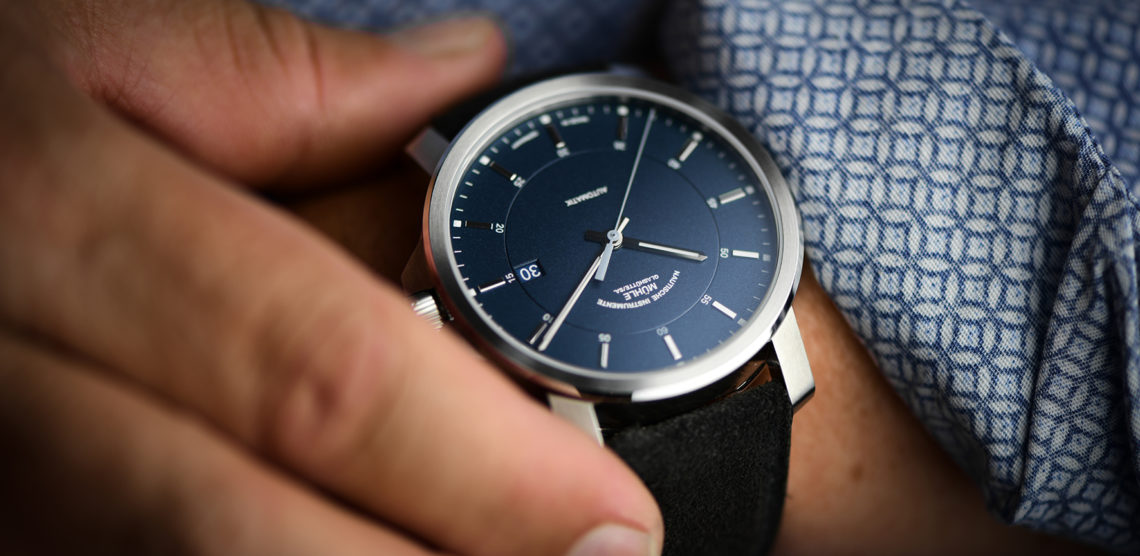
NAUTICAL VIRTUE
USEFUL INFORMATION ON WATERTIGHTNESS
We maintain our connection to our company’s nautical roots by placing particularly high value on the water resistance of our wristwatches. All Mühle watches in our current collection are therefore water-resistant up to a pressure of 5 bars or above, meaning that they can not only be worn when washing your hands, but also out in the rain. In addition, we always make sure that our watches have a certain safety margin when it comes to water resistance. This is because watch cases are made up of numerous materials that can behave differently at different temperatures. This must be taken into account, for example, when jumping into water – especially if the watch has warmed up during previous sunbathing and cools down significantly in the water. The watch not only has to withstand the pressure when it hits the water, but also the vacuum caused by cooling.
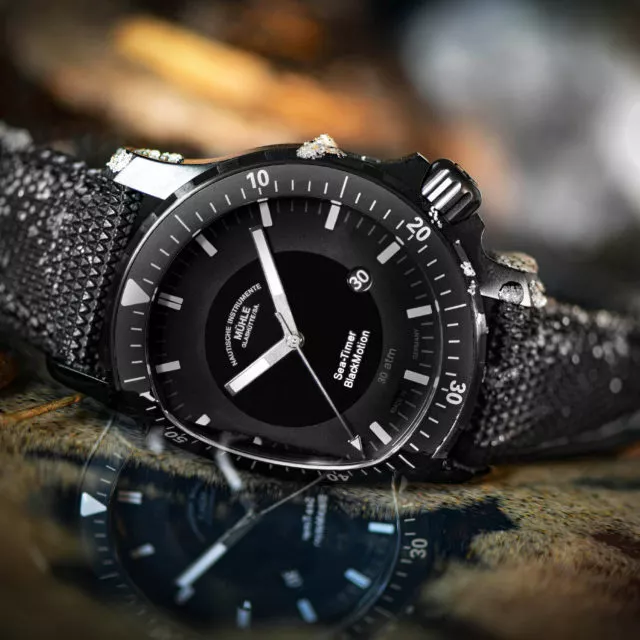
SAFETY FEATURES INCLUSIVE
WATCHES FOR SWIMMING OR DIVING
Watches with a watertightness of 10 bars or above are also suitable for use when swimming, for example all of our Teutonia or 29er models. If you want to wear your watch when diving, however, it needs to have slightly more pressure resistance, with at least 20 bars required according to the standard DIN 8310. Our Sea-Timer BlackMotion and ProMare models have a pressure resistance of 30 bars and are therefore ideally suited for use when doing all sorts of sports both above and under water.
LIGHT BREEZE
5 BAR
Washing your Hands, splashes
WIND AND WEATHER
10 BAR
Showers, baths, swimming
STORM AND DEEP SEA
30 BAR
Diving, snorkeling
HIGHLY RECOMMENDED
CHECK OF WATERTIGHTNESS
You should also bear in mind that the information on pressure resistance and watertightness provided applies to brand-new watches. The watertightness of your watch may deteriorate over time as a result of knocks or blows and other factors such as solar radiation, contact with cosmetics and chemical reactions with adhesives or paints can also cause its seals to become permeable to water. We therefore recommend that you get the watertightness of your watch checked every 1 to 2 years.
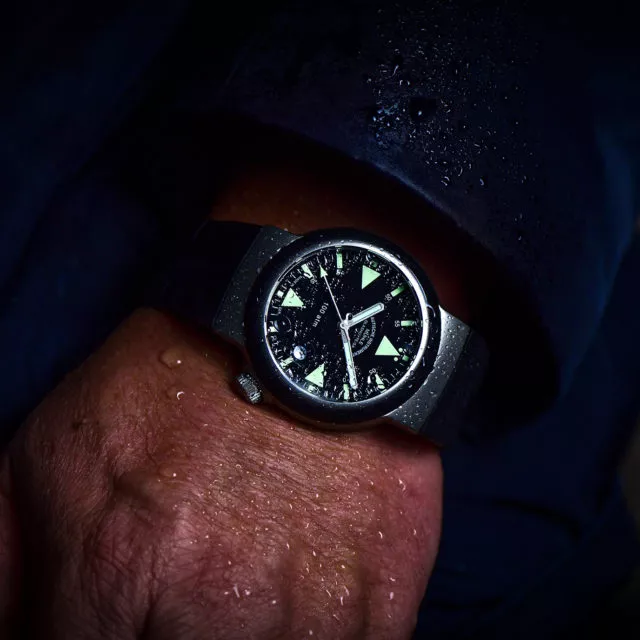
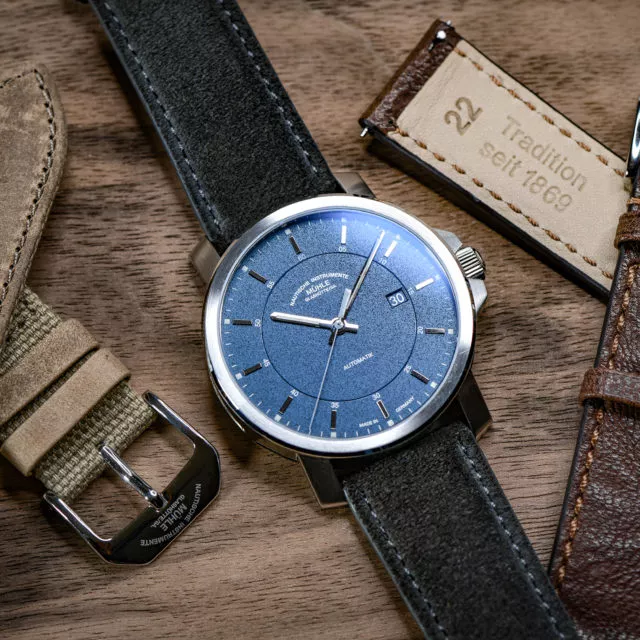
NATURAL PRODUCT
LEATHER STRAPS ARE AFRAID OF WATER
Leather straps should generally be kept away from water so that they maintain their shape and appearance over a long period of time. Our Russia leather straps have been specially treated in order to make them water-repellent and therefore ideally suited for use during outdoor activities. They should not, however, be worn when swimming or surfing. This also applies to our textile and suede leather straps. Since these are natural products, they react more strongly to environmental influences.
RINSE WELL
CLEANING AFTER CONTACT WITH CHLORINE OR SALT WATER
You should thoroughly rinse your watch in tap water after swimming or diving in the sea or pool. We also recommend that you do so after sailing or surfing. Please check whether the crown is in the correct position. If your watch has a screw-in crown, this should be screwed into the case until hand-tight, while a push-in crown should be pushed right into the case. The right crown position 0 is the only way to ensure that the watch is waterproof.

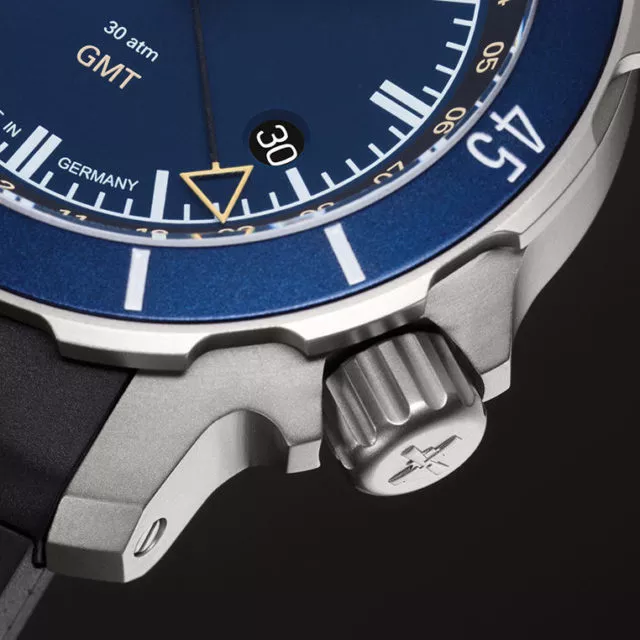
SAFETY FEATURES FOR SPORTS WATCHES
THE SCREW-IN CROWN
Let’s first clear up a myth: the watertightness of a watch has nothing to do with whether it has a screw-in or push-in crown. Even hand-wound watches, which generally do not have screw-in crowns, can be water-resistant up to 10 bars.
Whatever crown your watch has, one thing is extremely important: to ensure that your watch remains water-resistant, the crown always needs to be in the crown position (0). If your watch has a screw-in crown, this should be screwed into the case until hand-tight, while a push-in crown should be pushed right into the case.
If you wear a watch with a crown that has not been screwed or pushed in properly, for example when washing your hands, the crown may be accidentally pushed to one side. If this happens, the shaft may push the seal aside and water may get into the case. This may also happen if a push-in crown suffers a violent shock. To prevent this, sports watches in particular are fitted with screw-in crowns. If these are knocked, they remain firmly in place thanks to the screw connection.
HIGH PRECISION
WORTH KNOWING ABOUT THE MOVEMENT
Mühle watches are instruments for measuring time. An instrument has a specific function and must prove itself in daily use. This is especially true for a Mühle watch. It wants to and can be worn every day. Every Mühle watch is robust enough for a sporty, active lifestyle – be it the elegant Teutonia or the sporty ProMare. To ensure that they are ready for any adventure, we give them very specific qualities: the nautical virtues of precision, robustness and good readability. High robustness is made possible by our particularly shock-resistant woodpecker neck regulation. Easy readability is guaranteed by clean dials that show the time at a glance. Finally, our elaborate regulation in six layers ensures the best precision
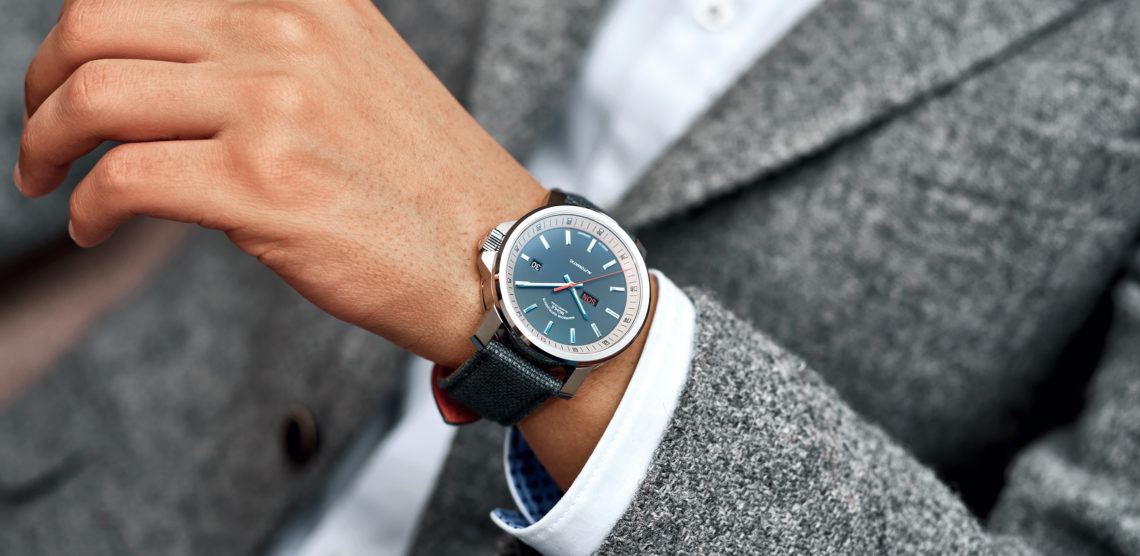
HIGHLY RECOMMENDED
THE PRECISION OF MECHANICAL WATCHES
It is normal for mechanical watches to display a certain amount of tolerance because fluctuating temperatures, the tension of the winder springs or the position in which a watch is stored when not being worn can all affect its accuracy. The accuracy of a new watch may, however, display deviations in the eight-week-long run-in period in particular. You should therefore wait until these eight weeks have passed before asking a specialist to measure your watch’s daily deviation and, where necessary, getting it adjusted.
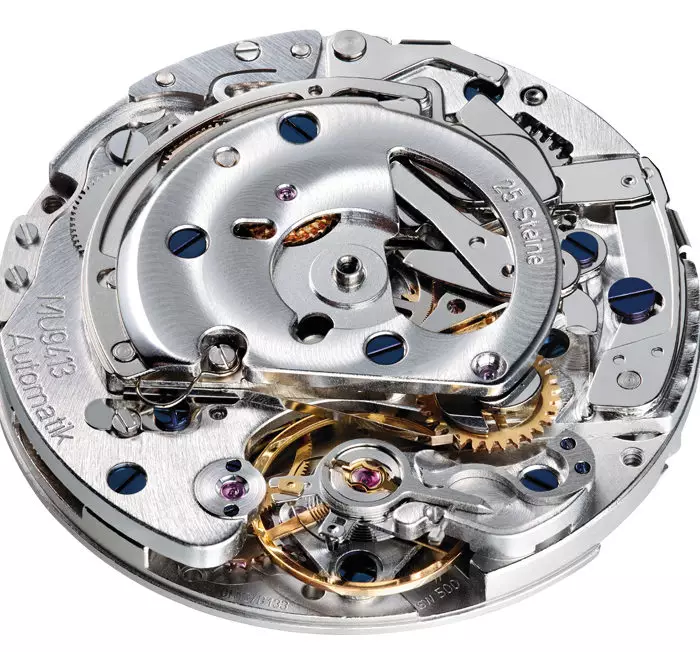

PARTICULARLY POLITE
REGULATING IN SIX POSITIONS
Every Mühle watch is regulated in all six positions in which a watch can be worn on the wrist. Our internal limits are oriented towards the chronometer standard, which stipulates that movements must maintain a precision of between 0 and a maximum of +8 seconds per day. One of the key aspects of our corporate philosophy is to ensure that Mühle watch wearers are never too late because of their time measuring instruments. Being a bit early is more polite than turning up late, which is why we regulate our watches so that they are always slightly fast.
BEST ON YOUR WRIST
STORAGE OF YOUR MÜHLE WATCH
Your Mühle watch feels most at home when sitting comfortably on your wrist, where every motion provides our automatic watches with the required winding energy and your body heat constantly keeps them at operating temperature. If you take off your watch or switch between different Mühle watches every once in a while, you should ideally store your unworn watches in their cases or in a cabinet where they are protected against dust, moisture and direct solar radiation. When storing your watch for a long time, we additionally recommend that you wind it up by hand once a month so that the different oils are always properly distributed throughout its movement.
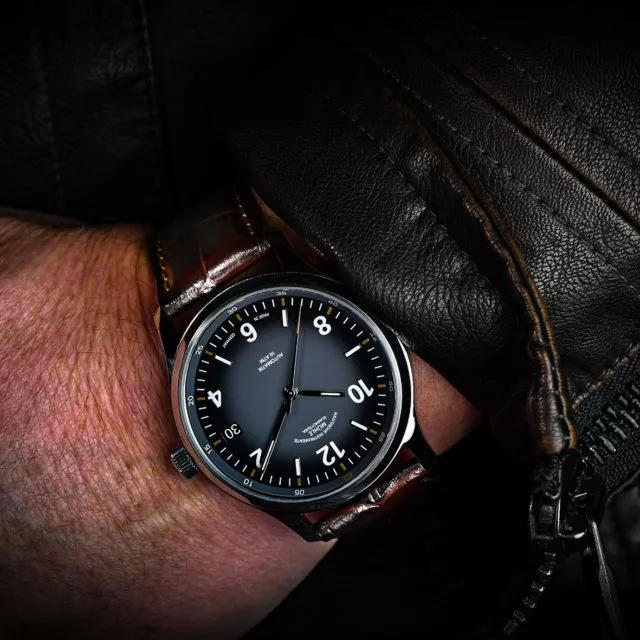
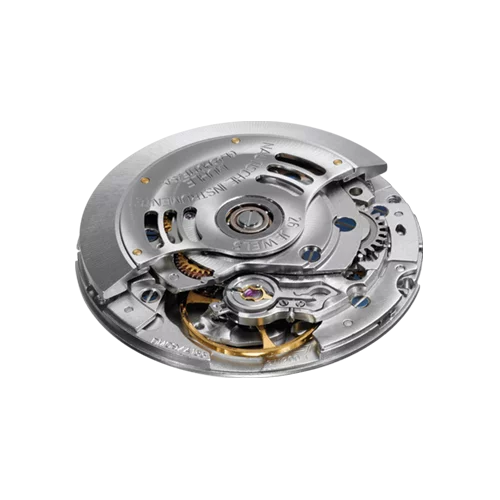
STYLISH AND COMFORTABLE
STORAGE IN A WATCH WINDER
Watch winders are the ideal solution for the extremely convenient storage of Mühle automatic watches because they wind them up on a regular basis. When using a watch winder, you need to use the specific settings required for your watch movement in order to ensure that it is optimally wound:
MU 9408, MU 9413 and MU9419: All of these chronographs mechanisms are movements that are wound on one side. You therefore need to adjust the settings of your watch winder so that it turns your watch in a clockwise direction/to the right when you look at the face of the watch. Rotations per day: 750
Selitta, Mühle version: The SW 200/220/221/240/260/290/330/400 mechanisms are movements that are wound on both sides. Your watch winder can therefore be set to rotate clockwise or counter-clockwise, but where possible, should be set to rotate in both directions. Rotations per day: 725
ETA, Mühle version: The ETA 2671/2824/2836/2892/2893/2895 mechanisms are movements that are wound on both sides. Your watch winder can therefore be set to rotate clockwise or counter-clockwise, but where possible, should be set to rotate in both directions. Rotations per day: 650
WHO HAS TURNED THE CLOCK
INFORMATION ON THE POWER RESERVE
The power reserve details provided for your Mühle watch are based on the remaining time for which it will run once it has been fully wound. Our chronograph mechanism, for example, has a power reserve of 48 hours when fully wound, meaning that a Mühle chronograph watch can be taken off and stored without being moved for 48 hours before stopping. If a watch does not receive enough energy through motion and is therefore not fully wound, it will stop earlier. You can additionally wind up your watch by hand in order to avoid this problem. You can reach your watch’s full power reserve by putting its crown in the winding position and turning it 20-30 times.
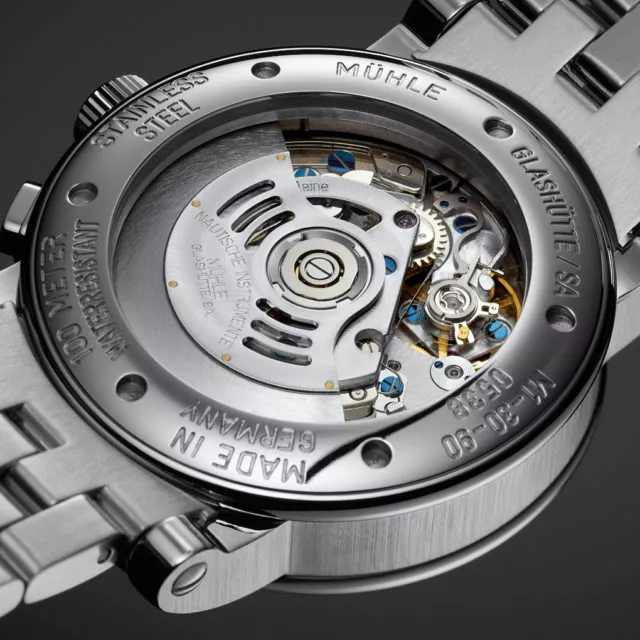
SUITABLE WEARING
WORTH KNWOING IN TERMS OF RUBUSTNESS AND RELIABILITY
Our wristwatches are characterized not only by the greatest possible precision, but also by their robustness and reliability. Thanks in particular to the patented woodpecker neck regulation, our watches can easily withstand occasional shocks. Nevertheless, a mechanical movement consists of many small components that react differently to shocks, heat and cold or other environmental influences. Here are some valuable tips on how to use your Mühle watch gently.

MINIMUM DISTANCE
ELECTRONICAL DEVICES AND MAGNETISM
Magnetic fields are not only present in close proximity to magnets, but also wherever an electrical current is to be found. Nevertheless, you can, of course, continue to wear your Mühle watch when travelling on the tram, drilling a hole in the wall with an electric drill or setting your radio alarm clock, none of which will affect your Mühle watch in the slightest. You should, however, avoid placing your watch on surfaces such as the loudspeaker of your hi-fi system or other electric devices or appliances. You should above all be sure to take off your watch before undergoing medical examinations in magnetic resonance tomographs (MRI/MRT scans) because these devices create extremely strong magnetic fields.
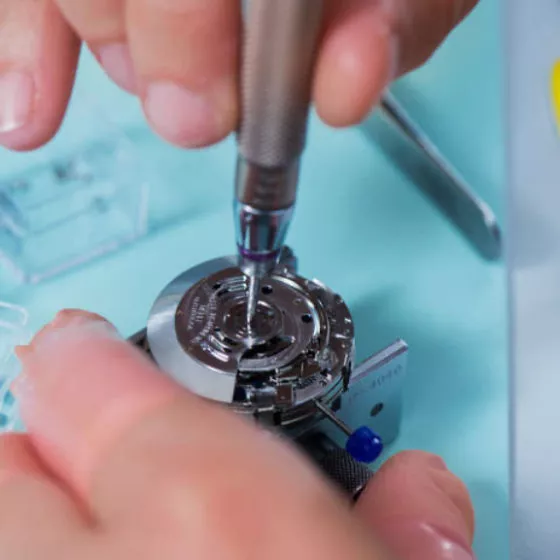
TOUGH BUT FINE MECHANISM
AVOID KNOCKS AND BLOWS
Mechanical movements consist of a large number of small cranks, screws, wheels and spindles that all work together with the lowest possible tolerances. Knocks and blows can impair the function of such a fine mechanism. As a result, your Mühle watch should be kept away from avoidable knocks and from regular blows in particular, for example those caused by chopping wood, even though our patented woodpecker neck regulation enables it to cope well with the odd knock and blow. By avoiding such impacts, you can not only protect the multitude of tiny components in your watch’s movement, but also prevent the appearance of ugly scratches on its case.
TEMPERATURE SHOCK
PLACING ON EXTREM TEMPERATURED AREAS
If you prefer not to wear your watch during the night, you should try to avoid placing it on cold stone, glass or metal surfaces. Areas that reach extremely high temperatures are also unsuitable for the storage of your mechanical watch. If you want to take off your watch when driving a long distance, you should not place it on surfaces such as your dashboard.


STYLISH AND COMFORTABLE
STORAGE IN A WATCH WINDER
Watch winders are the ideal solution for the extremely convenient storage of Mühle automatic watches because they wind them up on a regular basis. When using a watch winder, you need to use the specific settings required for your watch movement in order to ensure that it is optimally wound:
MU 9408, MU 9413 and MU9419: All of these chronographs mechanisms are movements that are wound on one side. You therefore need to adjust the settings of your watch winder so that it turns your watch in a clockwise direction/to the right when you look at the face of the watch. Rotations per day: 750
Selitta, Mühle version: The SW 200/220/221/240/260/290/330/400 mechanisms are movements that are wound on both sides. Your watch winder can therefore be set to rotate clockwise or counter-clockwise, but where possible, should be set to rotate in both directions. Rotations per day: 725
ETA, Mühle version: The ETA 2671/2824/2836/2892/2893/2895 mechanisms are movements that are wound on both sides. Your watch winder can therefore be set to rotate clockwise or counter-clockwise, but where possible, should be set to rotate in both directions. Rotations per day: 650
WHO HAS TURNED THE CLOCK
INFORMATION ON THE POWER RESERVE
The power reserve details provided for your Mühle watch are based on the remaining time for which it will run once it has been fully wound. Our chronograph mechanism, for example, has a power reserve of 48 hours when fully wound, meaning that a Mühle chronograph watch can be taken off and stored without being moved for 48 hours before stopping. If a watch does not receive enough energy through motion and is therefore not fully wound, it will stop earlier. You can additionally wind up your watch by hand in order to avoid this problem. You can reach your watch’s full power reserve by putting its crown in the winding position and turning it 20-30 times.

